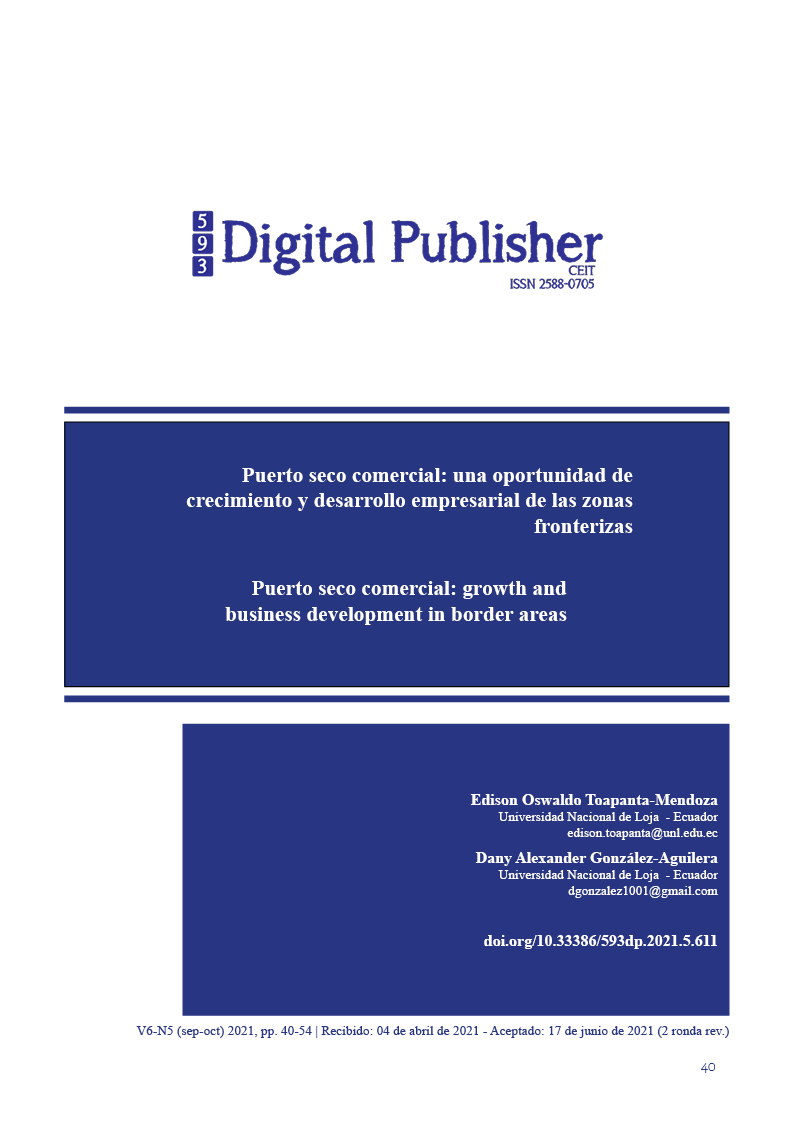Puerto seco comercial: growth and business development in border areas
Main Article Content
Abstract
Commercial areas or commercial dry port, to allow organize and distribution of mass consumption products and integrate economic activities to strengthen the internal logistics of a city. This work analyzes the viability of the creation of a commercial port in the Loja city, and the impact that it would generate on the demand for products and services and the economic and social development. Through the application of a survey, we realize a market analysis and viability study of the creation the commercial port. In this work we evaluated the relevance of the commercial port and the effect on the transport flows and accessibility of the products in the city. The results demonstrated the viability of the creation the commercial port in economic, logistics and social factors.
Downloads
Article Details

This work is licensed under a Creative Commons Attribution-NonCommercial-ShareAlike 4.0 International License.
1. Derechos de autor
Las obras que se publican en 593 Digital Publisher CEIT están sujetas a los siguientes términos:
1.1. 593 Digital Publisher CEIT, conserva los derechos patrimoniales (copyright) de las obras publicadas, favorece y permite la reutilización de las mismas bajo la licencia Licencia Creative Commons 4.0 de Reconocimiento-NoComercial-CompartirIgual 4.0, por lo cual se pueden copiar, usar, difundir, transmitir y exponer públicamente, siempre que:
1.1.a. Se cite la autoría y fuente original de su publicación (revista, editorial, URL).
1.1.b. No se usen para fines comerciales u onerosos.
1.1.c. Se mencione la existencia y especificaciones de esta licencia de uso.
References
Agatić, A., Čišić, D., Perić Hadžić, A., & Poletan Jugović, T. (2019). The One Belt One Road (OBOR) initiative and seaport business in Europe–perspective of the Port of Rijeka. Pomorstvo, 33(2), 264-273.
ACTE (2000): “Benefi cios de los centros de transporte. Asociación de centros de transporte de España”.
Banús, L. (2012): “El Puerto Seco de Antequera, clave para la logística del Sur de España”. Interempresas. Logística Interna. Área Informativa, 27.02.12 [en línea] http://www.interempresas.net/Logistica/ Articulos/62075-En-marcha-el-Puerto-Seco-de-Antequera-enclave-estrategico-e-intermodal.html [consulta: 12 marzo 2012].
Antún, J. P., & Alarcón, R. (2020) Distribución urbana de mercancías en la Ciudad de México: tendencias corporativas y políticas públicas. Estudios Iberoamericanos en Ingeniería de Tránsito, Transporte y Logística, 288.
BID. (2019). Como lograr puertos más eficientes. Retrieved from https://blogs.iadb.org/integracion-comercio/es/eficientes-puertos/
Bourgoin, Jeremy y Castella, Jean (2011). “PLUP FICTION”: landscape simulation for participatory land use Planning in northern Lao PDR. Mountain Research and Development, vol. 31, nº 2, Berna, p. 78-88.
Clavijo, S., Vera, N., & Vera, A. (2013). La inversión en infraestructura en Colombia 2012-2020. Efectos fiscales y requerimientos financieros. Carta Financiera anif, (161), 7-14.
Ceballos - Ramírez, S. L., & Guisao - Giraldo, Érica Y. (2020). ¿Un patio de contenedores, en el Oriente Antioqueño?. Revista Científica Profundidad Construyendo Futuro, 13(13), 62-69. https://doi.org/10.22463/24221783.2659
Elvira Maeso Gónzalez (2003): Presente y futuro de los servicios logísticos en Andalucía. Ed Universidad de Sevilla, Secretariado de Publicaciones, Pág. 28
Estrada, J. (2006). Las reformas estructurales y la construcción del orden neoliberal en Colombia. En A. E. Ceceña, Los desafíos de las emancipacionees en un contexto militarizado (págs. 247 - 284). Buenos Aires: Clacso.
Farole, T. y Akinci, G. (2011), Special Economic Zones: Progress, Emerging Challenges, and Future Directions, Washington, DC, The International Bank for Reconstruction and Development/The World Bank.
Gómez, Gustavo y Delgado, Ovidio (1998). Espacio, territorio y región: conceptos básicos para un proyecto nacional. Cuadernos de Geografía, p. 1-2.
Gómez Zaldívar, F., & Molina, E. (2018). Zonas Económicas Especiales y su impacto sobre el desarrollo económico regional. Problemas del desarrollo, 49(193), 11-32.
González, E. M., Blanca, J. C., & Mellado, F. A. S. (2012). Impacto del puerto seco de Antequera en el sistema logístico andaluz. Revista de Estudios Regionales, (95), 149-174.
Herrera, S. Y. G. (2019). Verticalidades y horizontalidades en la configuración de la Sabana Occidente como puerto seco de Bogotá. territorios, (41), 197-222.
Komchornrit, K. (2017). The selection of dry port location by a hybrid CFA-MACBETH-PROMETHEE method: a case study of Southern Thailand. The Asian Journal of Shipping and Logistics, 33(3), 141-153.
Martínez, P. M. (2016). La metropolización afectada por la globalización: reflexión epistemológica sobre la nueva revolución urbana. Cuadernos de Geografía: Revista Colombiana de Geografía, 25(2), 77-105. Doi: https://doi. org/10.15446/rcdg.v25n2.56907
Núñez, S. A., Cancelas, N. G., & Orive, A. C. (2015). Establecimiento de los factores a considerar para determinar la zona de ubicación de un puerto seco y de sus jerarquías a través de un panel DELPHI. Revista Transporte y Territorio, (13), 100-121.
Qiu, X., Wong, E. Y., & Lam, J. S. L. (2018). Evaluating economic and environmental value of liner vessel sharing along the maritime silk road. Maritime Policy & Management, 45(3), 336-350.
Rincón, M. P. (2011). Bogotá Región Central. Transformaciones recientes en las dinámicas de ocupación del territorio. Bogotá: Universidad Nacional de Colombia.
Romero, H. P., Galván, N. R., & Pulgarín, D. E. R. (2020). El puerto de Manzanillo: un reto para la infraestructura logística de México.
Wong, K.-Y. y Chu, D. K. (1984), “Export processing Zones and Special Economic Zones as Generators of Economic Development: The Asian Experience”, Geografiska Annaler, Series B: Human Geography.
Xie, J., Sun, Y., & Huo, X. (2021). Dry Port-Seaport Logistics Network Construction under the Belt and Road Initiative: A Case of Shandong Province in China. Journal of Systems Science and Systems Engineering, 30(2), 178-197.



